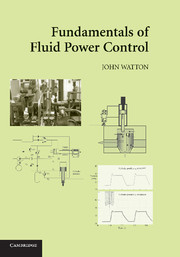2 - An Introduction to Fluid Properties
Published online by Cambridge University Press: 05 June 2012
Summary
Fluid Types
The preferred working fluid for most applications is mineral oil, although in some applications there is a requirement for a water-based or synthetic fluid, mainly for reasons of fire hazards and increasingly for environmental considerations. The drive toward nonmineral oil fluids has seen a renewed attitude to pure water hydraulics together with the emergence of biodegradable and vegetable-based fluids. Fire-resistant fluids in use fall under the following classifications:
HFA 5/95 oil-in-water emulsion, typically 5% oil and 95% water
HFB 60/40 water-in-oil emulsion, typically 60% oil and 40% water
HFC 60/40 water-in-glycol emulsion, typically 60% glycol and 40% water
HFD synthetic fluid containing no water
HFE synthetic biodegradable fluid
The use of water-based fluids has implications for component material selection – for example, the use of stainless steel, plastics, and ceramics. In addition, serious consideration of fluid properties must also be given, particularly viscosity, which can be very high at low temperatures in some cases. Fluids are being continually developed, and the following information is intended to reflect the general trend and is not considered as definitive because this would require an overview of many suppliers from many countries around the world – for example, see www.shell.com.
Type HFA 5/95 oil-in-water emulsions are fire-resistant emulsions that exhibit enhanced stability, lubrication, and antiwear characteristics and have the following important aspects:
They have much improved stability toward variations in temperature, pressure, shear, and bacterial attack.
The performance limitations become obvious for systems operating well above 70 bar, reliability and efficiency often being sacrificed where fire resistance is of paramount importance.
[…]
- Type
- Chapter
- Information
- Fundamentals of Fluid Power Control , pp. 33 - 60Publisher: Cambridge University PressPrint publication year: 2009

